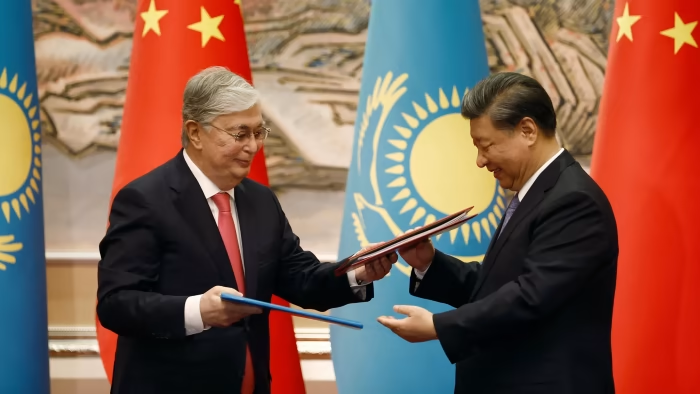During the unprecedented war between Israel and Iran over the past weeks (June13-24), the United States has obviously supported Israel against Iran in all real terms since they are the closest allies in the Middle East. It is fair to say that Washington and Jerusalem have persisted in dismissing Iran’s legitimate security concerns in the region while making all efforts to undermine the strategic coordination of the anti-American bloc—mainly by China, Russia, Iran and North Korea.
During this period, China and five Central Asian countries also held the second summit in Astana during June 16-18, followed by a joint statement. Moreover, the Treaty of Permanent Good-Neighborliness and Friendly Cooperation was signed as one of the historic documents by China and Kazakhstan, Kyrgyzstan, Tajikistan, Turkmenistan and Uzbekistan.
The six parties hail the treaty as a milestone for today and a foundation for tomorrow. Given China + Central Asia covering the huge territory from the Caspian Sea to the entire maritime coast of China, this area embraces the central location of Eurasia, which is termed as the Heartland of the world.
Given the geopolitical dimensions of China + Five Central Asia countries, they might be able to advance a new paradigm in regional cooperation, moving decisively from the aspirational consensus of the inaugural summit in 2023 to a more concrete and actionable agenda.
Read More: Uzbek President Proposes Initiatives to Boost China-Central Asia Ties
Accordingly, this summit in Astana represents more than a mere diplomatic gathering, it more likely represents the maturation of a relationship grounded in what Chinese President Xi termed the “China-Central Asia spirit” – a shared vision of mutual respect, mutual trust, mutual benefit, and mutual assistance. It refers to the consensus that they consent to frame a partnership focused on delivering practical and long-term prosperity and stability in a stark contrast to the war scenario in the Middle East and other conflicts across the world.
For China + Central Asia countries, the synergy among them go beyond the geopolitics since the leaders struck 12 cooperation deals which emphasize practical results and regional partnership in trade, energy and education over political grand-standing. Meanwhile, they vow to uphold a fair, equitable international order, as well as an equal, orderly world structure.
Such language aligns with frequent statements by China that has advocated for global stability to enable nations both large and small to progress, and for building a global community of shared future. As the second largest economy, China has promised to provide $208 million in aid to tackle four major developmental challenges facing the region, e.g. a lack of access to the sea, inadequate development of the financial sector, the absence of a coordinated policy on water and energy resources, and climate change. It is worth noting that China’s recent investments in the region have totaled $30 billion.
It is also noted that unlike the G7 gathering in Canada recently, where the top leader of the Western bloc left early, hinting at “commitments” to the ongoing Israel-Iran conflict and then approving the U.S. strategic bombard against the Iranian nuclear facilities, the six leaders in Astana Summit appealed to halting the ongoing military escalation between the contending parties and to advancing a ceasefire in the Gaza Strip, describing negotiations as the only path to regional stability.
Read More: China–Central Asia Summit: Powerful Push for Economic Cooperation
Moreover, they vowed to make sure Central Asia “not be an outsider of the conflict; never being involved alone into the conflict; joint build more international consensus through the Group of Friends for Peace and play a constructive role in promoting a political settlement of the crisis concerned; finally safeguard the legitimate rights and core interests of Central Asia states.
Since it was not merely regional diplomacy, the Astana Summit was in effect a summit of substance. The list of outcomes published refers to a relationship that is both broad in scope and deep in its practical application. The key deliverables include a host of meticulously negotiated agreements covering everything from trade facilitation and industrial investment to agricultural modernization and people-to-people exchanges.
This follows a period of robust growth, with trade between China and the five Central Asian states soaring to a record $94 billion in 2024. This emphasis on high-quality development signals a move towards more sustainable, technologically advanced, and environmentally conscious projects under the umbrella of the Belt and Road Initiative, addressing some of the early criticisms of the program and aligning it with the long-term development goals of the Central Asian states.
In sum, the logic underpinning the China-Central Asia partnership is that development is the most effective guarantor of peace and stability. By fostering economic growth, creating jobs, and improving livelihoods, the initiatives launched in Astana aim to address the root causes of conflict and instability. A politically-united, economically-integrated and socially-interconnected Central Asia will be one day a more resilient regional community, better equipped to withstand external shocks.
To that end, China is not only the most important trade and investment partner in the region, but also working with all parties to assure that any coercive geopolitics and unilateral protectionism will not be tolerated.
Wang Li
The writer is Professor of International Studies, Jilin International Studies University (JISU)



